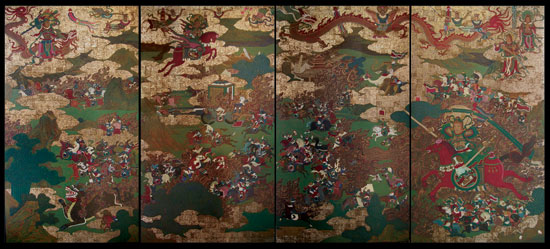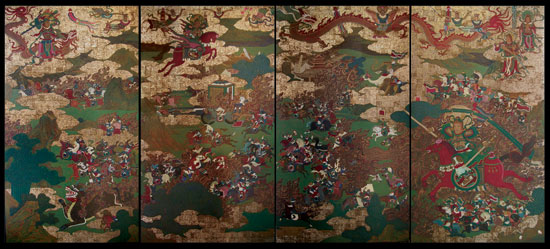No 1, Vol.6, January – February 2016
Saint Giong,1993, Acrylic, leaves bronze on canvas, 145 x 320 cm
I had first come across the work of the artist Nguyen Quang Vinh at an exhibition two months previously. I had been delighted by his expressive series of seascapes. Now, I was on my way to his studio cum home out in the boondocks of Binh Thanh District to see his private exhibition. I was soon to learn that there was much more about him than meets the eye. I had been told it was behind the Oncology Hospital. That I found easily. It was clearly marked by a sickly-looking middle-aged gentleman with a cigarette drooping from his mouth seated by a wall with the sign ‘Benh Vien Ung Buou’ directly above spiraling smoke. Then I turned into a labyrinth of alleyways. This is not going to be easy, I thought. But no, by following the number system I soon found myself at the Q’Vinh Studio, though you have to admit that it is quaintly odd to have six separate houses all numbered 110. And there to greet me was the congenial Ong Quang Vinh himself.
Remembrance II, 2015, oil, sand on canvas, 180 x 600cm
Ong Quang Vinh is now fifty-two years old. For the last twenty years, he has worked as a teacher at the Fine Arts University. This exhibition is on three levels and it is crammed with pieces from all periods of his life. There are plenty that he has only just recently completed and even one that is still work in progress. But this is also a retrospective of a remarkable and varied career dating back to his student days in Moscow. He has never been one to stand still or rest on his laurels, it seems. These days, it is the seascapes he concentrates on, but there are also abstract works, classical still life pieces, a series which feature inserts of the Mona Lisa, portraiture, anthropomorphic portraits of dogs and cats dressed in jackets, city paintings of Hanoi and Saigon and even one nude painting.
Remembrance II, 2015, oil, sand on canvas, 180 x 600cm
First, a look at the paintings from his Russian experience, most of which were part of his course work. There is a haunting portrait of a Russian woman, probably in her late fifties. It is realistic, but it is her character, warm and wise, that he seems to have captured best. Then, there is a frieze in traditional oriental style of the legendary giant Saint Going, who defended the Viet from aggression from the North. Equivalent perhaps to King Arthur of English legend, we see him in many scenes in armour, on horseback, dragons flying about him and wielding his lance and when that breaks, a bamboo pole. At first, I thought this was a lacquer painting, but it is just clever technique that creates that illusion. As with most of the collection (a notable exception uses ceramic tiles), it is, in fact, acrylic on canvass. From the Russians, Q’Vinh learned classical still life with pitch-black backgrounds. ‘You have to paint many layers’, the artist explained to me. If it were not for the oriental plates and pots and the tropical fruits, you might have thought these pieces that relax the viewer so were produced by a European Grand Master some centuries ago. 
It was the half-dozen or so cat and dog portraits that gave me the light relief. I hope that was the intent. The colourful and exaggerated eyes and extra floppy ears enhanced the natural cuteness of these creatures. Then, under those heads, you see the animals dressed smartly in jackets and shirts. I asked the artist if he had ever heard of the English artist Louis Wain, whose sole genre was anthropomorphized cats and kittens. He had not, but seemed intrigued. Perhaps one day people will say of Vietnamese cats and dogs what was said of Wain’s animals-“English cats that do not look and live as his cats are ashamed of themselves.” But then this is only one of many topics that versatile Q’ Vinh treats.
There was a period when this artist fell seriously under the muse of the Mona Lisa. There are a number of pieces which are mainly abstract but feature square cameos of Leonardo’s famed sitter. There is even one which hearkens back to Andy Warhol’s Campbell soup pop art. It is a whole frame of American dollar banknotes with the lady in question replacing George Washington.
On to the artist’s current preoccupation; namely the seascapes. Ah the sea! What a topic to paint. How beautiful and majestic she can be. She is the mother of all life on earth and yet how quickly she can switch to broody moods and how quickly our attitude toward her can change from awe-inspiring to dark fears of it engulfing our civilisations and of reclaiming us by drowning. Quang Vinh’s seascapes-more expressive than realistic-achieve all this with waves crashing onto rocks, rain pouring down on turbulent water and raging storms. To capture the full grandeur of the ocean means painting on a large canvass. This he does both vertically and horizontally; one of the latter would fit well on my stairway wall, I dreamed. There are two smaller ones, though, of Ke Ga Island with its lighthouse and the waters around it looking dark and somber in contrast to the bright sunny days of my two visits there.
In an age when anyone can pile up bricks in a corner and call it art and himself an artist, it is refreshing to encounter a professional who not only has innate ability, but has applied himself over many years to master new techniques. Quang Vinh is not one to let the grass grow beneath his feet, but is in constant exploration for new riches within himself. I have not come across an artist with such courage and versatility before. If you put four or five of his pictures of different genres in an exhibition you would think they were by different artists. Now that is what I call a true Master of Art!n
The Q’ Vinh private studio is located at 5/101/6 No Trang Long Street, Binh Thanh District, HCMC.

